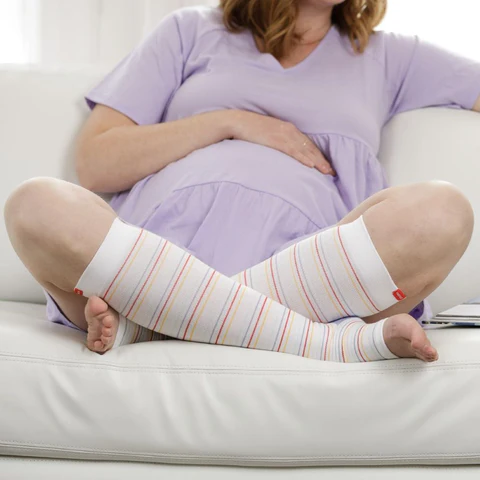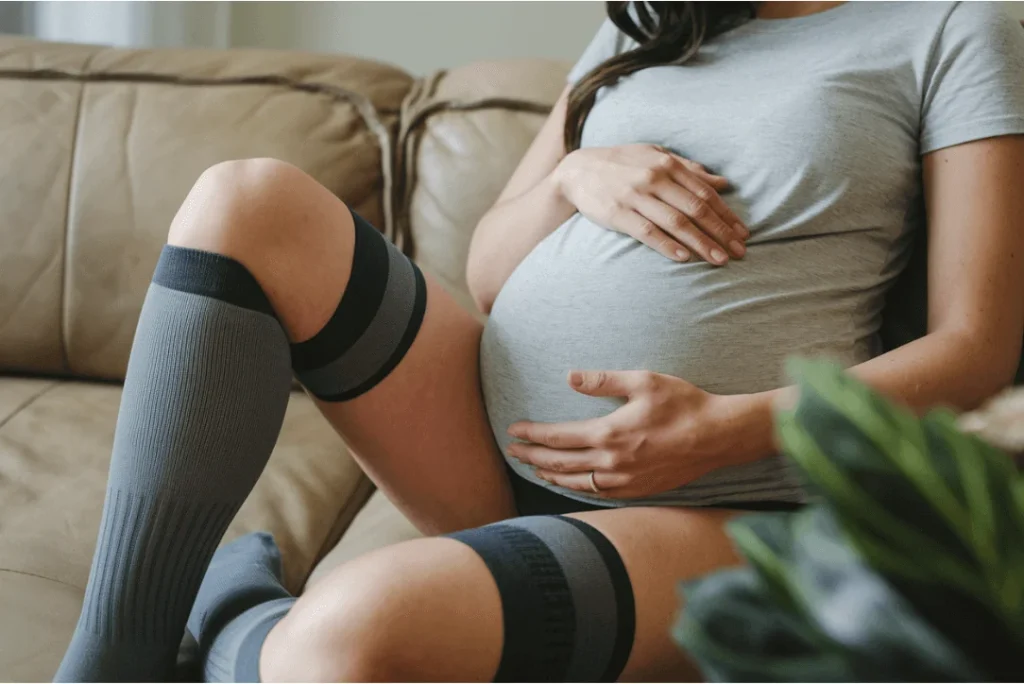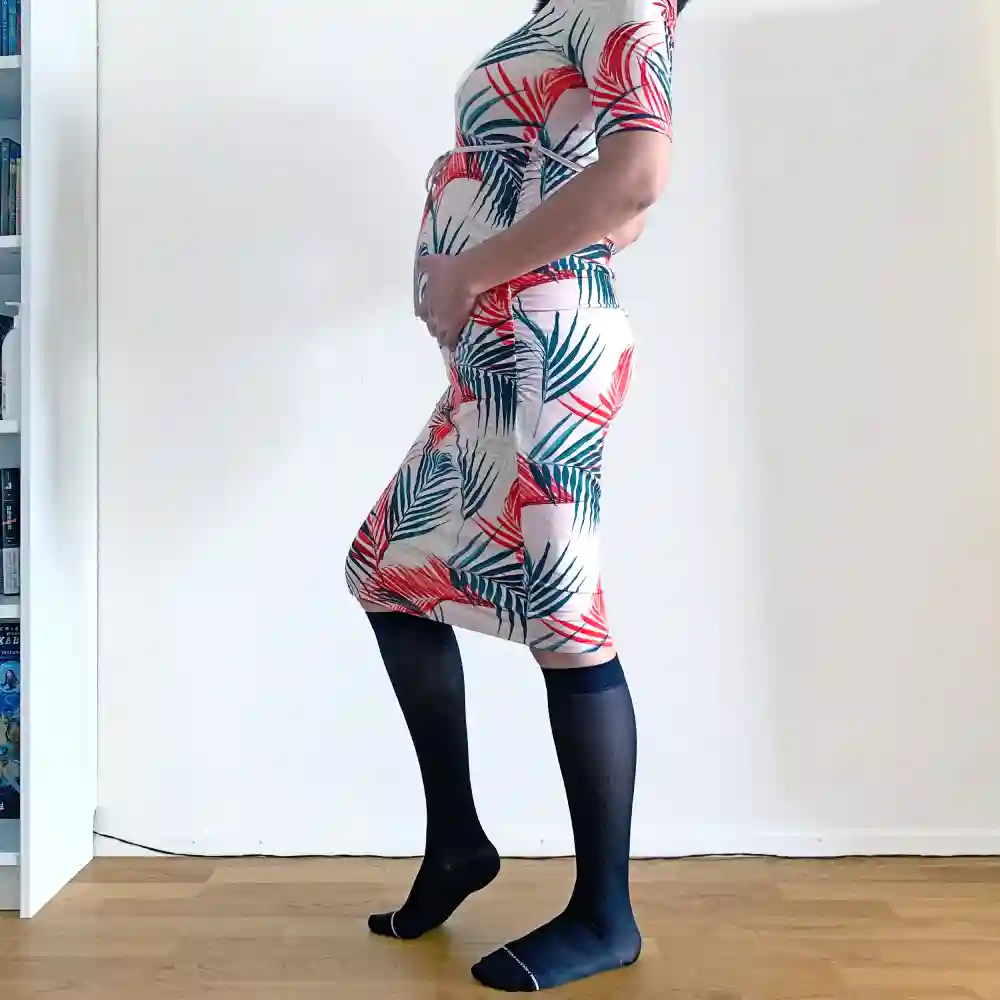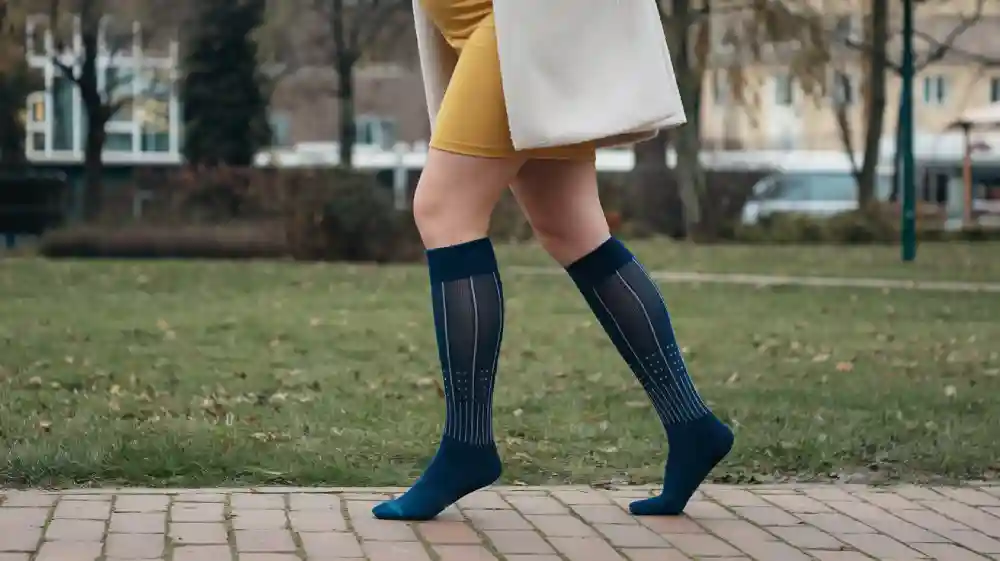Compression Sock Trends in Pregnancy Retail
In today’s maternity market, support products have become essential for expectant mothers seeking comfort and health during pregnancy. The global maternity support products market, which includes items like maternity belts, support bands, and compression socks, was valued at approximately $2.01 billion in 2023 and is projected to reach $4.81 billion by 2032, growing at a CAGR of 10.2%.
The maternity support market presents a lucrative opportunity for brands and retailers, but it is not without its challenges. High pricing remains a significant barrier, making essential maternity products inaccessible to many expectant mothers. Lack of awareness further hinders demand—many women are simply unaware of the benefits of compression socks, missing out on the relief they offer from swelling, discomfort, and circulation issues. Additionally, the rise of sustainability-conscious consumers has reshaped the market, increasing demand for eco-friendly materials while restricting options that fail to meet environmental standards.
Despite these constraints, brands and retailers can seize this opportunity by offering affordable, high-quality, and sustainable compression socks tailored for pregnancy. Partnering with specialized manufacturers allows for cost-efficient production, private labeling, and product customization, ensuring differentiation in a competitive market. Expanding distribution channels, both online and offline, improves accessibility, while consumer education initiatives—leveraging influencers, digital content, and in-store campaigns—can bridge the awareness gap. By addressing these challenges head-on, businesses can position themselves at the forefront of a growing market, capturing demand and driving long-term profitability.

Maternity Compression Sock Market Pain Points
Common Retail Challenges: Compression Sock Demand vs. Supply
The demand for maternity legwear has been rising steadily, yet supply chain disruptions, production limitations, and fluctuating material costs pose significant challenges for retailers. Many businesses struggle to maintain inventory levels, especially during peak seasons. When stock runs low, customers turn to competitors, resulting in lost sales opportunities. To stay ahead, partnering with a reliable factory that offers flexible production capacity and efficient lead times is essential. A customized bulk order strategy can help retailers avoid stock shortages while ensuring product consistency.
Consumer Complaints: Fit, Comfort & Quality Issues
Fit-related concerns are one of the top reasons for returns and negative feedback. Pregnant women require legwear that accommodates swelling, weight fluctuations, and sensitive skin. Poorly designed options may dig into the skin, roll down, or lose elasticity too quickly. Retailers that prioritize ergonomic designs, premium materials, and thorough quality testing will gain customer trust. Working directly with a manufacturer to refine sizing, fabric selection, and non-slip features ensures a more comfortable wearing experience, reducing refund rates and enhancing brand reputation.
Pricing Pressures: Balancing Cost & Profitability
Balancing affordability with profitability remains a struggle. Expectant mothers often seek cost-effective solutions, yet premium materials and specialized designs drive up production costs. Additionally, competitors may offer lower-priced alternatives that compromise on quality. The key to success lies in sourcing directly from a cost-efficient factory, optimizing bulk pricing, and leveraging private label options. Offering tiered pricing models—such as standard, premium, and eco-friendly selections—helps retailers appeal to different customer segments without sacrificing margins.
Branding Struggles: Differentiating Compression Sock Products
With many maternity legwear brands flooding the market, standing out is becoming increasingly difficult. Customers are drawn to brands that offer unique designs, superior comfort, and strong messaging. Custom branding opportunities—including exclusive patterns, personalized packaging, and sustainable fabric options—can create a strong identity that resonates with buyers. Partnering with a manufacturer that supports private labeling and custom design features enables businesses to build a distinct brand image while meeting consumer demand for high-quality, functional maternity wear.
Essential Functions of Compression Socks for Pregnancy
Relieving Swelling: Promoting Blood Circulation, Reducing Fluid Retention
During pregnancy, hormonal changes and increased pressure on the veins often lead to swelling in the legs and feet. Many expectant mothers struggle with fluid retention, making everyday activities uncomfortable. Properly designed maternity legwear applies gentle pressure to the lower limbs, improving circulation and preventing excessive swelling. This targeted support helps redistribute fluids more efficiently, reducing puffiness and discomfort. Retailers should focus on offering breathable, stretchable fabrics that adapt to body changes, ensuring a secure yet comfortable fit throughout all trimesters.
Preventing Blood Clots: Lowering DVT Risks for Expectant Mothers
Prolonged sitting or standing increases the risk of deep vein thrombosis (DVT), a serious condition where blood clots form in the legs. This risk is particularly high for pregnant women during long flights, car rides, or extended work hours. The right leg support product gently enhances blood flow, reducing the likelihood of clot formation. For brands, educating customers on these health benefits through packaging, marketing content, and in-store displays can boost consumer confidence and drive sales. Providing graded pressure options ensures that women can choose the level of support that best meets their needs.

Improving Discomfort: Reducing Leg Fatigue and Varicose Veins
As the body undergoes significant changes, many women experience leg fatigue, aching muscles, and the development of varicose veins. The added weight and increased blood volume during pregnancy put extra strain on the lower limbs, leading to discomfort that worsens over time. A well-structured support garment helps reduce muscle soreness and supports proper vein function, alleviating pain and preventing long-term complications. To stay competitive, retailers should highlight features such as reinforced arch support, cushioned soles, and moisture-wicking properties, ensuring a product that not only relieves symptoms but also enhances daily comfort.
By offering customized designs and high-quality materials, retailers can position themselves as go-to suppliers for maternity support essentials. Partnering with a trusted factory enables seamless product customization, helping businesses cater to the unique demands of expectant mothers while staying ahead in the market.
Choosing the Right Compression Socks for Pregnant Women
Compression Levels: Matching Support to Specific Needs
Selecting the correct pressure level is essential to ensure comfort and effectiveness. Expectant mothers have varying needs based on lifestyle, swelling severity, and medical conditions.
- Mild (15-20 mmHg): Suitable for daily wear, this level provides light support, reducing minor swelling and fatigue. It’s ideal for women who are on their feet often but don’t experience severe discomfort.
- Moderate (20-30 mmHg): Recommended for those who stand for long hours or travel frequently, this option offers more structured support. It helps prevent leg strain and reduces the risk of circulation issues.
- Medical Grade (>30 mmHg): Reserved for those with significant venous problems, this level requires medical approval. It is typically used for severe swelling or clot prevention under professional guidance.
For brands and retailers, offering a range of pressure levels ensures broader market appeal. Educating customers about these variations through packaging or online product descriptions can drive better purchase decisions.

Material Considerations: Enhancing Comfort and Performance
The right fabric can make a significant difference in comfort, particularly for pregnant women who are more prone to skin sensitivity and temperature fluctuations.
- Breathable Fabrics: Options like bamboo fiber, nylon, and spandex ensure airflow, preventing discomfort from excessive heat and moisture. These materials are lightweight yet durable.
- Cotton Options: A good choice for those with sensitive skin or conditions like diabetes, cotton provides a softer feel and absorbs moisture effectively.
Brands and retailers should prioritize high-quality, stretchable, and moisture-wicking fabrics to maximize comfort and wearability. Custom material blends, tailored to different consumer needs, can further differentiate a product line.
Length Options: Choosing the Right Coverage
The length of maternity legwear plays a crucial role in effectiveness and convenience.
- Below-Knee Style: The most popular choice, this option covers the calves while avoiding pressure on the knees. It effectively reduces swelling in the lower legs and is easy to wear throughout the day.
- Thigh-High & Pantyhose Styles: Designed for those experiencing swelling above the knees, these provide extended support but may be prone to slipping if not fitted properly.
Offering various length choices ensures that customers can select a style suited to their comfort and mobility preferences. Providing adjustable options, such as silicone grips or reinforced bands, enhances usability and reduces slipping concerns.
By working with a specialized manufacturer, retailers can customize pressure levels, fabrics, and lengths to meet the demands of their target audience. This ensures both quality assurance and a competitive edge in the maternity market.
Customization: Compression Sock Solutions for Retailers
Brands can elevate their market position by collaborating directly with factories to create private-label designs tailored to pregnancy needs. Integrate logos, maternity-themed patterns, or ergonomic features like adjustable bands to differentiate your offering. For example, floral motifs or breathable bamboo blends align with both aesthetic trends and functional demands. Partnering with manufacturers ensures cost-efficient bulk orders and fast production cycles—critical for meeting peak demand without stockouts.
Retailers benefit from tiered packaging options, such as gift-ready boxes for premium lines or minimalist designs for budget-conscious buyers. Backed by rigorous quality control, these customized solutions address common consumer complaints like slippage or discomfort while reinforcing brand loyalty. Offer bundled kits (daily wear + travel pairs) or scenario-specific packaging to simplify purchasing decisions. By focusing on purpose-driven customization, brands turn generic products into lifestyle essentials for expectant mothers.
Recommendations for Use: Ensuring Maximum Comfort & Effectiveness
- Best Wearing Practices: Maximizing Daily Support
To achieve the best results, timing and duration matter. Encourage customers to put them on first thing in the morning, before swelling begins. This ensures optimal support throughout the day. Expectant mothers should aim to wear them for a maximum of 12 hours, as prolonged use may cause discomfort. Removing them at night allows the skin to breathe and prevents excessive pressure buildup.
Retailers should highlight these wearing guidelines in product packaging or online descriptions, helping customers make informed choices. Providing easy-to-follow usage instructions can enhance the user experience and reduce dissatisfaction.
- Wearing Techniques: Enhancing Comfort & Fit
Proper application is key to avoiding discomfort and ensuring even pressure distribution. Silicone non-slip bands help prevent rolling or slipping, while donning aids—such as rubber gloves or long-handled tools—make it easier to slide them on without overstretching the fabric.
For a smooth fit, advise users to ensure the material lays flat against the skin, without wrinkles. Uneven fabric placement can create pressure points, leading to irritation. Retailers can enhance customer satisfaction by offering instructional videos or step-by-step guides, demonstrating the best techniques for hassle-free wear.

- Travel Tips: Reducing Risks on Long Journeys
Extended periods of sitting, such as during flights or long car rides, can worsen swelling and increase the risk of circulation issues. Pregnant women should wear them before traveling, ensuring continuous support throughout the journey. Staying hydrated and performing simple ankle exercises, like foot flexes and circles, helps maintain proper blood flow.
To prevent discomfort, customers should avoid overly tight options, as excessive compression can restrict circulation rather than improve it. Retailers can cater to this concern by offering adjustable styles or varied pressure levels, allowing users to find the right balance of support and comfort.
By addressing these key recommendations, brands can educate consumers, improve product usability, and reinforce the value of maternity legwear, ultimately driving sales and customer loyalty.
Medical Opinions & Safety Considerations
Effectiveness Debate: How Well Do They Work?
Medical experts widely acknowledge the benefits of targeted leg support during pregnancy, particularly in reducing swelling and improving circulation. Several studies indicate that consistent use can lower the risk of asymptomatic deep vein thrombosis (DVT), a condition where blood clots develop in the legs due to restricted movement. However, there is limited evidence proving their effectiveness in preventing life-threatening clots, such as pulmonary embolism.
The American Heart Association advises expectant mothers to combine legwear use with regular movement and proper hydration. Simply wearing supportive garments without making lifestyle adjustments may not provide complete protection against circulation-related complications. Retailers should educate customers on incorporating daily activity and proper fluid intake for maximum effectiveness.
High-Risk Groups: Who Should Take Extra Precautions?
While many pregnant women can benefit from added leg support, some individuals require medical consultation before use. Those at a higher risk of circulation issues include:
- Obese individuals who experience excessive pressure on the lower limbs
- Older adults whose veins may already have reduced elasticity
- Smokers with an increased likelihood of vascular problems
- Individuals with a history of venous disease, such as varicose veins or past clotting issues
For these groups, choosing the right level of pressure is crucial. Retailers should ensure product descriptions clearly indicate different support levels, helping customers make informed decisions based on their specific needs. Providing guidance on when to seek medical advice before purchasing can also help enhance customer trust and satisfaction.
By addressing both benefits and precautions, businesses can position themselves as responsible suppliers, offering both effective solutions and the right consumer education to ensure safe use.
Precautions & Maintenance for Compression Socks
- Avoiding Excessive Compression: Finding the Right Fit
Choosing the correct level of support is essential for both comfort and safety. Overly tight legwear can restrict circulation instead of improving it, leading to discomfort, numbness, or even skin irritation. Expectant mothers with sensitive skin or pre-existing circulation concerns should be especially cautious.
Retailers should offer clear size charts and fitting guides to help customers select the best option. Providing different pressure levels and adjustable designs allows women to find the right balance between support and flexibility. Highlighting these factors in marketing materials can help reduce return rates and improve customer satisfaction.
- Proper Cleaning & Care: Extending Product Lifespan
Maintaining product elasticity and effectiveness requires proper washing techniques. Frequent exposure to heat or harsh detergents can weaken the fabric, reducing durability.
To maximize longevity:
- Machine wash in cold water or opt for hand washing with mild detergent.
- Avoid high-heat drying—air drying preserves elasticity and prevents shrinkage.
- Do not wring or twist, as this can damage the compression structure.
Retailers can boost customer trust by including care instructions on packaging and offering video tutorials or product inserts. Well-maintained products not only last longer but also provide consistent support throughout pregnancy.
- Adjusting Fit: Customization for Maximum Comfort
Every woman’s body changes differently during pregnancy, making adjustability a key feature. Standard sizes may not always provide the perfect fit, leading to slipping or discomfort.
Offering custom sizing options and stretchable fabrics ensures a better experience. Retailers should also emphasize designs with reinforced bands, seamless stitching, and flexible panels to accommodate swelling and shifting body weight. A well-fitted product not only enhances comfort but also improves long-term brand loyalty.
By focusing on proper fit, care, and comfort, businesses can provide a superior product that meets the expectations of expecting mothers while strengthening their brand presence in the maternity market.
Conclusion: Elevating Retail with Compression Sock Solutions
The demand for maternity support products continues to grow, presenting a valuable opportunity for brands and retailers. Expectant mothers are actively seeking solutions to alleviate discomfort, improve circulation, and enhance overall well-being during pregnancy. However, standing out in this expanding market requires more than just offering generic products—it demands high-quality, customizable, and consumer-focused solutions.
By partnering with a specialized manufacturer, you can ensure custom designs, premium materials, and cost-efficient bulk production, allowing your business to deliver maternity legwear that meets both style and functionality needs. Contact us today to explore bulk order options, private labeling, and exclusive customization features.
FAQs
What features should a high-quality maternity compression sock include?
Expectant mothers require gradual pressure distribution, breathable materials, and a flexible fit to accommodate changes in leg size throughout pregnancy. Features such as moisture-wicking fabrics, seamless construction, reinforced toe and heel areas, and non-slip cuffs improve wearability and prevent discomfort.
How do I ensure my compression socks meet regulatory and safety standards?
Regulations vary by region, but maternity legwear should comply with FDA (U.S.), CE (Europe), and ISO standards for medical-grade textiles. Retailers should work with certified manufacturers that conduct compression level testing, durability assessments, and skin safety checks to ensure their products meet quality standards.
What sustainability options are available for maternity compression socks?
Many manufacturers now offer organic cotton, bamboo fiber, and recycled nylon options. Eco-conscious consumers prefer sustainable choices, so offering biodegradable packaging and ethically sourced materials can increase brand appeal.
Are maternity compression socks a good fit for brick-and-mortar stores, or are they better suited for online sales?
Both channels can be effective, but retail stores benefit from in-person fittings, helping customers find the right size and style. Online stores, however, can attract a wider audience and benefit from digital marketing strategies. Providing detailed size charts, instructional videos, and customer testimonials online can help reduce return rates and increase conversions.
Should I offer maternity compression socks in multipacks?
Yes! Many expectant mothers need multiple pairs for daily rotation. Offering:
- 3-pair value packs (for long-term wear)
- Mix-and-match color sets (for aesthetic variety)
- Subscription discounts (for recurring purchases)
Can increase customer retention and average order value.
